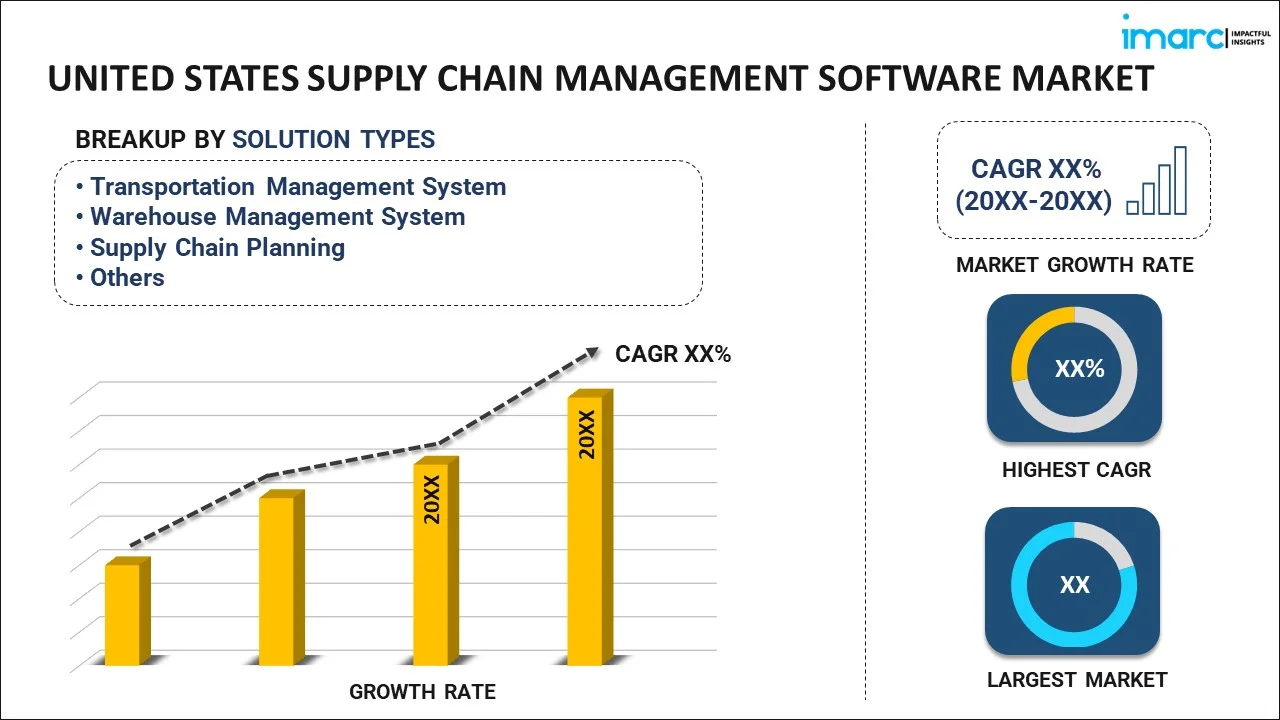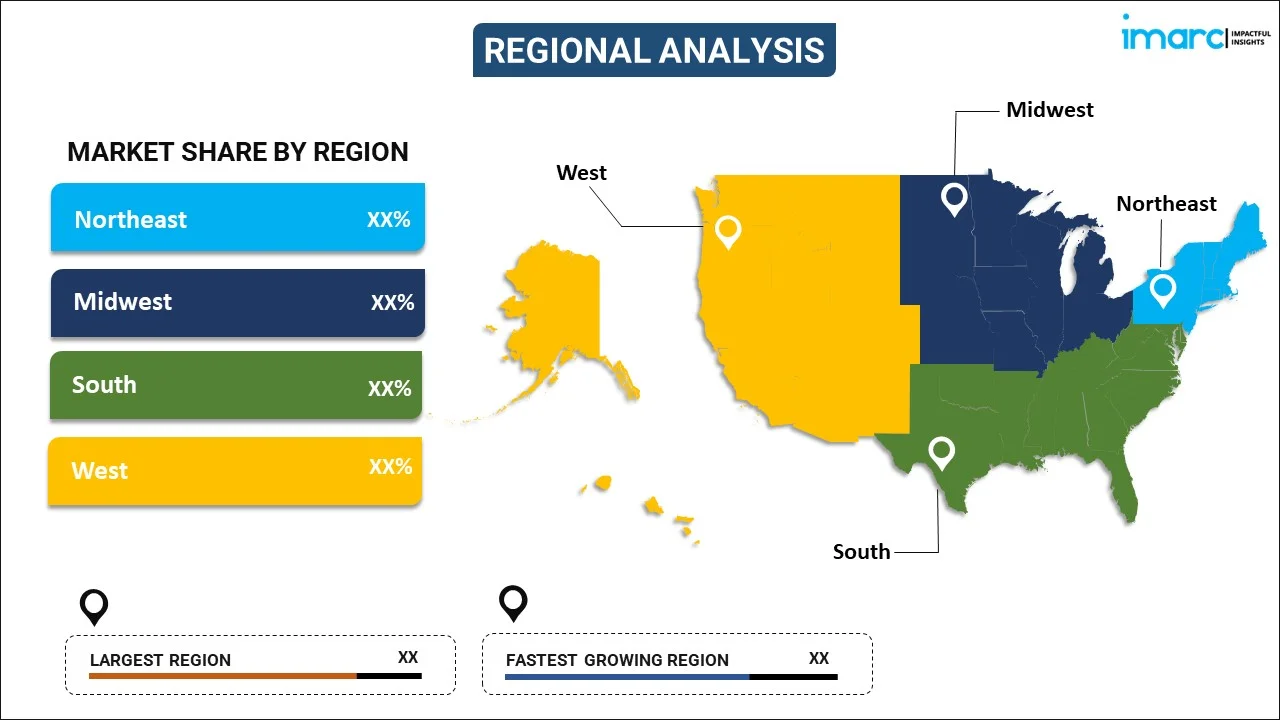
United States Supply Chain Management Software Market Report by Solution Type (Transportation Management System, Warehouse Management System, Supply Chain Planning, Procurement and Sourcing, Manufacturing Execution System), Deployment Mode (On-premises, Cloud-based), Organization Size (Small and Medium-sized Enterprises, Large Enterprises), Industry Vertical (Retail and Consumer Goods, Healthcare and Pharmaceuticals, Manufacturing, Food and Beverages, Transportation and Logistics, Automotive, and Others), and Region 2024-2032
Market Overview:
United States supply chain management software market size is projected to exhibit a growth rate (CAGR) of 4.65% during 2024-2032. The inflating need among various organizational departments, including sales and marketing, customer services, and support, for elevating client experience and foster robust connections with potential customers is primarily driving the market growth.
|
Report Attribute
|
Key Statistics
|
|---|---|
|
Base Year
|
2023 |
|
Forecast Years
|
2024-2032 |
|
Historical Years
|
2018-2023
|
| Market Growth Rate (2024-2032) | 4.65% |
Supply chain management (SCM) software plays a crucial role in fortifying and overseeing the comprehensive processes within an organization's supply chain. It encompasses various segments like supply chain planning, transportation management system (TMS), warehouse management system (WMS), and manufacturing execution system, offering standard solutions such as supplier management, order processing, demand forecasting, logistics, warehouse management, collaboration, and security maintenance. The primary objective of SCM software is to optimize and reinforce an organization's supply chain operations by overseeing production, inventory, sourcing, transportation, and monitoring product demand. It enhances visibility through cross-functional access and provides platforms for exception-based process management.
United States Supply Chain Management Software Market Trends:
The United States supply chain management software market is witnessing robust growth as organizations increasingly recognize the strategic value of comprehensive supply chain solutions. This market encompasses a range of software solutions, including supply chain planning, transportation management systems (TMS), warehouse management systems (WMS), and manufacturing execution systems. Additionally, with standard functionalities like supplier management, order processing, demand forecasting, logistics, warehouse management, collaboration, and security maintenance, SCM software is designed to optimize and strengthen end-to-end supply chain processes. Moreover, its applications span overseeing production, inventory, sourcing, and transportation, ensuring effective monitoring of product demand. The advantages of supply chain management software are multifaceted, offering improved visibility, heightened operational efficiency, cost reduction, and risk mitigation. It facilitates compliance adherence, automates critical processes, and plays a pivotal role in decision-making, problem-solving, customer service, and communication. The U.S. market is further fueled by the increasing complexity of supply chain dynamics and the need for businesses to navigate supply chain challenges effectively. Apart from this, the software is instrumental in transforming supply chain management into a strategic asset, contributing significantly to the evolution of modern supply chain practices in the United States, which is anticipated to fuel the market growth over the forecasted period.
United States Supply Chain Management Software Market Segmentation:
IMARC Group provides an analysis of the key trends in each segment of the market, along with forecasts at the country level for 2024-2032. Our report has categorized the market based on solution type, deployment mode, organization size, and industry vertical.
Solution Type Insights:

- Transportation Management System
- Warehouse Management System
- Supply Chain Planning
- Procurement and Sourcing
- Manufacturing Execution System
The report has provided a detailed breakup and analysis of the market based on the solution type. This includes transportation management system, warehouse management system, supply chain planning, procurement and sourcing, and manufacturing execution system.
Deployment Mode Insights:
- On-premises
- Cloud-based
A detailed breakup and analysis of the market based on the deployment mode have also been provided in the report. This includes on-premises and cloud-based.
Organization Size Insights:
- Small and Medium-sized Enterprises
- Large Enterprises
The report has provided a detailed breakup and analysis of the market based on the organization size. This includes small and medium-sized enterprises and large enterprises.
Industry Vertical Insights:
- Retail and Consumer Goods
- Healthcare and Pharmaceuticals
- Manufacturing
- Food and Beverages
- Transportation and Logistics
- Automotive
- Others
A detailed breakup and analysis of the market based on the industry vertical have also been provided in the report. This includes retail and consumer goods, healthcare and pharmaceuticals, manufacturing, food and beverages, transportation and logistics, automotive, and others.
Regional Insights:

- Northeast
- Midwest
- South
- West
The report has also provided a comprehensive analysis of all the major regional markets, which include Northeast, Midwest, South, and West.
Competitive Landscape:
The market research report has also provided a comprehensive analysis of the competitive landscape in the market. Competitive analysis such as market structure, key player positioning, top winning strategies, competitive dashboard, and company evaluation quadrant has been covered in the report. Also, detailed profiles of all major companies have been provided.
United States Supply Chain Management Software Market Report Coverage:
| Report Features | Details |
|---|---|
| Base Year of the Analysis | 2023 |
| Historical Period | 2018-2023 |
| Forecast Period | 2024-2032 |
| Units | Million US$ |
| Scope of the Report | Exploration of Historical Trends and Market Outlook, Industry Catalysts and Challenges, Segment-Wise Historical and Future Market Assessment:
|
| Solution Types Covered | Transportation Management System, Warehouse Management System, Supply Chain Planning, Procurement and Sourcing, Manufacturing Execution System |
| Deployment Modes Covered | On-premises, Cloud-based |
| Organization Sizes Covered | Small and Medium-sized Enterprises, Large Enterprises |
| Industry Verticals Covered | Retail and Consumer Goods, Healthcare and Pharmaceuticals, Manufacturing, Food and Beverages, Transportation and Logistics, Automotive, Others |
| Regions Covered | Northeast, Midwest, South, West |
| Customization Scope | 10% Free Customization |
| Report Price and Purchase Option | Single User License: US$ 3699 Five User License: US$ 4699 Corporate License: US$ 5699 |
| Post-Sale Analyst Support | 10-12 Weeks |
| Delivery Format | PDF and Excel through Email (We can also provide the editable version of the report in PPT/Word format on special request) |
Key Questions Answered in This Report:
- How has the United States supply chain management software market performed so far and how will it perform in the coming years?
- What has been the impact of COVID-19 on the United States supply chain management software market?
- What is the breakup of the United States supply chain management software market on the basis of solution type?
- What is the breakup of the United States supply chain management software market on the basis of deployment mode?
- What is the breakup of the United States supply chain management software market on the basis of organization size?
- What is the breakup of the United States supply chain management software market on the basis of industry vertical?
- What are the various stages in the value chain of the United States supply chain management software market?
- What are the key driving factors and challenges in the United States supply chain management software?
- What is the structure of the United States supply chain management software market and who are the key players?
- What is the degree of competition in the United States supply chain management software market?
Key Benefits for Stakeholders:
- IMARC’s industry report offers a comprehensive quantitative analysis of various market segments, historical and current market trends, market forecasts, and dynamics of the United States supply chain management software market from 2018-2032.
- The research report provides the latest information on the market drivers, challenges, and opportunities in the United States supply chain management software market.
- Porter's five forces analysis assist stakeholders in assessing the impact of new entrants, competitive rivalry, supplier power, buyer power, and the threat of substitution. It helps stakeholders to analyze the level of competition within the United States supply chain management software industry and its attractiveness.
- Competitive landscape allows stakeholders to understand their competitive environment and provides an insight into the current positions of key players in the market.
Need more help?
- Speak to our experienced analysts for insights on the current market scenarios.
- Include additional segments and countries to customize the report as per your requirement.
- Gain an unparalleled competitive advantage in your domain by understanding how to utilize the report and positively impacting your operations and revenue.
- For further assistance, please connect with our analysts.
 Inquire Before Buying
Inquire Before Buying
 Speak to an Analyst
Speak to an Analyst
 Request Brochure
Request Brochure
 Request Customization
Request Customization




.webp)




.webp)












